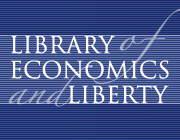
Merton H. Miller |

The Modigliani-Miller theorem says that under certain assumptions, the value of a firm is independent of the firm's ratio of debt to equity (see Corporate Debt). Miller once gave a colorful analogy to try to simplify his and Modigliani's insight, which he relates in Financial Innovations and Market Volatility:
Think of the firm as a gigantic tub of whole milk. The farmer can sell the whole milk as it is. Or he can separate out the cream, and sell it at a considerably higher price than the whole milk would bring. (Selling cream is the analog of a firm selling debt securities, which pay a contractual return.) But, of course, what the farmer would have left would be skim milk, with low butter-fat content, and that would sell for much less than whole milk. (Skim milk corresponds to the levered equity.) The Modigliani-Miller proposition says that if there were no cost of separation (and, of course, no government dairy support program), the cream plus the skim milk would bring the same price as the whole milk.
Miller was a strong defender of the view that the futures contracts are, just like other products, valuable to those who buy them. Therefore, he argued, government regulation of these contracts is likely to do more harm than good.
Miller earned his undergraduate degree at Harvard University in 1944 and went on to work as a tax expert at the Treasury Department. He later earned his Ph.D. in economics at Johns Hopkins University. He taught at Carnegie from 1953 to 1961, and in 1961 became a professor at the University of Chicago's Graduate School of Business. He was the Robert R. McCormick Distinguished Service Professor there. He became a public governor of the Chicago Mercantile Exchange in 1990.
(With Franco Modigliani.) "Corporate Income Taxes and the Cost of Capital." American Economic Review 53 (June 1963): 433-43.
(With Franco Modigliani.) "The Cost of Capital, Corporation Finance, and the Theory of Investment." American Economic Review 48 (June 1958): 261-97.
Financial Innovations and Market Volatility. 1991.
